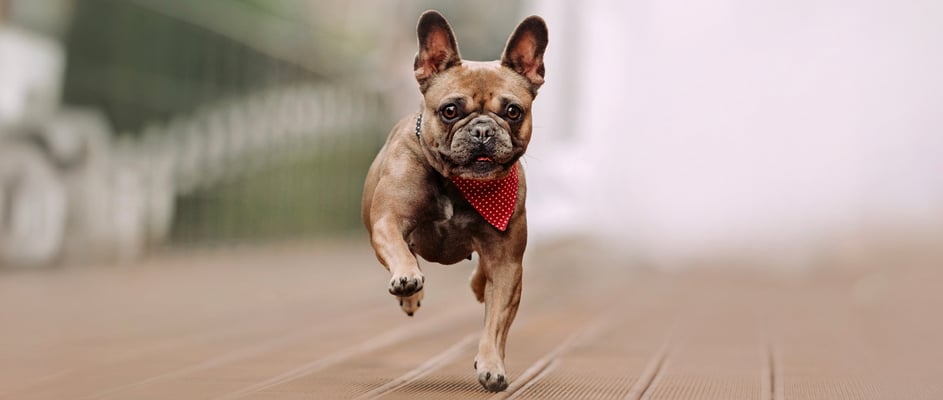The guide to owning a French Bulldog.
Want to know everything there is to know about finding the right dog for you? Submit your email below, and we’ll send you a one-stop guide to help you on your pet-ownership journey.
Jump to:
Stats at a glance.
A history of French Bulldogs.
Meet the French Bulldog, or the Bouledogue as the French might say! If you peer back through history, you’ll discover that these charming little companions are related to the English Bulldogs.
During the Industrial Revolution, lace workers from Nottingham in England emigrated to Northern France in search of opportunities. They brought with them smaller or “toy” Bulldogs, lovingly referred to as toy Bulldog types, who gradually evolved into the Bouledogue Français that we know today.
Unlike their larger Bulldog cousins, the French Bulldog’s original purpose wasn’t to fight or guard, but to serve as an adaptable companion.
These small canines settled in the countryside, content to warm laps and protect homes from rodents. Slowly, they made their way to French cities, fraternised with artists and writers, then later crossed the English Channel.
Today, Frenchies are known for being one of the world’s most beloved dogs.
That signature wrinkly face, combined with a playful spirit, has endeared them to countless families.
Curious about other rare or unusual breeds? Feel free to check out our article on Britain’s most rare dog breeds.
You’ll see how unique the Frenchie’s journey really is and how they compare to other extraordinary pups.
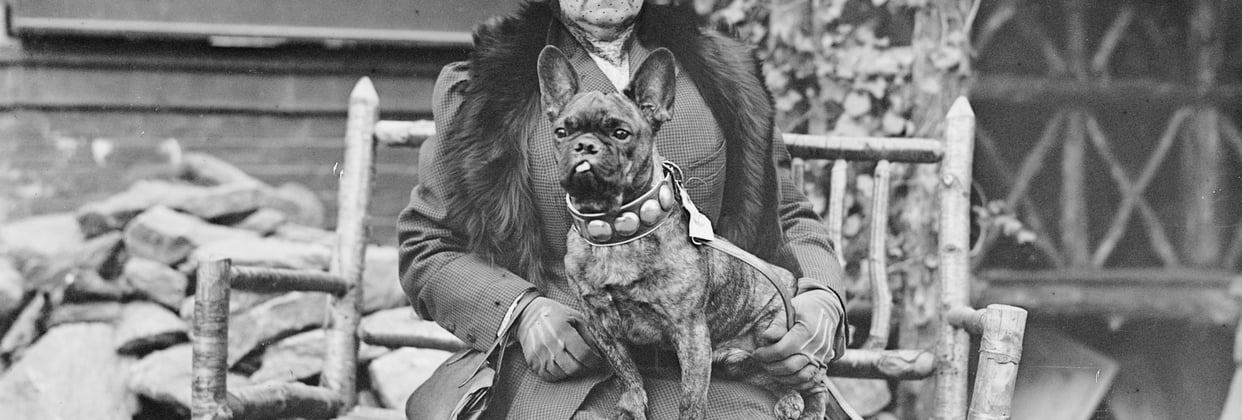

How much is a French Bulldog puppy (UK)?
Thinking of buying a French Bulldog puppy? Let’s discuss the investment. In the UK, these pups can range anywhere from £1,000 up to £3,000 or more.
Prices typically vary based on breeder reputation, the pup’s lineage, and their coat colours (for instance, fawn, brindle, or rarer shades).
In addition, if the parents boast champion bloodlines, you can expect prices to go even higher.
Need more general tips about puppy planning? See our puppy essentials guide.
If you’re a first-timer, you might also find it helpful to read our essential guide to buying a puppy.
Colours and coat types.
Colours
French Bulldogs come in a variety of classic colours, including fawn, brindle, cream, and white.
You’ll spot many with fetching black masks, as well as “pied” coats (large patches of colour contrasting with white).
If you’re a fan of unique patterns, Frenchies certainly deliver. Some lines have black-and-tan or chocolate tints, but standard show lines typically revolve around the more traditional colours.
Coat types
In terms of coat texture, the French Bulldog’s fur is short, smooth, and easy to groom. It’s not wiry like a terrier, nor is it particularly long and silky.
This breed is known for low-maintenance coats, meaning you don’t have to spend hours brushing.
But a quick grooming session once or twice a week helps remove dead hairs and keep their skin in tip-top condition.





Size and weight.
French Bulldogs typically measure around 28-33cm tall at the shoulder. Their weight can span from about 8kg up to 14kg, especially if they develop a sturdy frame.
Viewed from the side, Frenchies have that characteristic “front-heavy” stance, broad across the chest, and narrower toward the hindquarters.
Despite their smallish frame, these dogs have a surprising amount of muscle. That barrel-like chest often reminds you that their ancestors were smaller versions of powerful Bulldogs.
Use caution though, as obesity can quickly aggravate their risk of developing breathing difficulties and joint problems. A well-controlled diet and moderate exercise keep them strong without tipping into unhealthy weight territory.
If you’re trying to compare these dimensions to other canines, you might enjoy seeing how they stack up next to the top 10 small breeds. This can help you better visualise whether the Frenchie’s compact size is suited to your lifestyle.
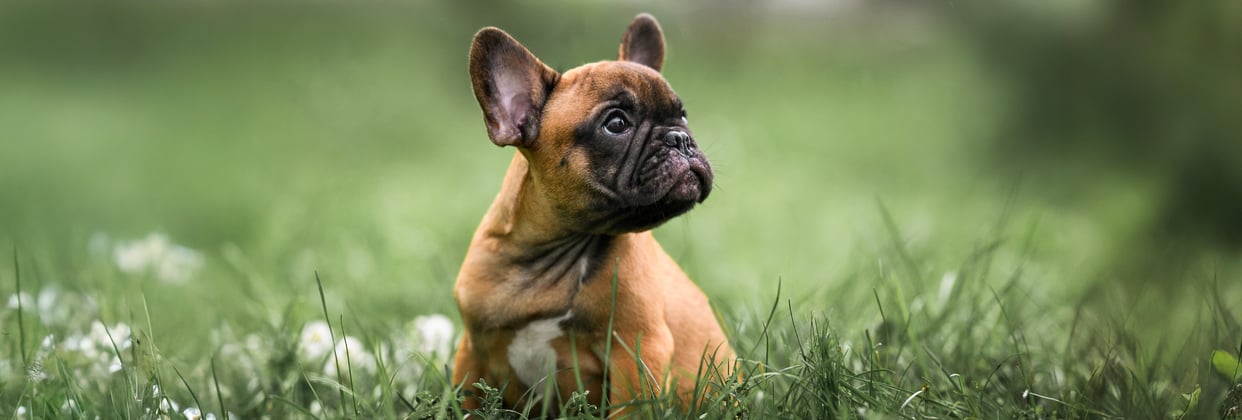

Temperament and behaviour.
Temperament
Don’t let their squat bodies fool you. Frenchies have enormous personalities lurking behind those soulful eyes.
They’re often described as playful, alert, and wonderfully affectionate. They adore human companionship and tend to get attached to their owners, following you around the house and plopping themselves on your lap at every turn.
Because they’re so social, French Bulldogs can develop separation anxiety if left alone for too long.
They thrive with families committed to spending quality time interacting, playing, and training.
If you’re searching for a dog who’s comfortable living in an apartment, a Frenchie can be a fantastic choice, as they don’t require huge outdoor spaces.
You just have to strike the right balance of mental and physical stimulation.
Do French Bulldogs make good pets?
Absolutely! These little charmers can be a perfect fit for many households, whether single professionals, retirees, or families with older children.
Everyone in the household generally falls in love with the Frenchie’s gentle, clownish nature.
But, if you have very young children, we recommend supervision to make sure those adorable bat ears don’t get accidentally tugged.
If you’re ever curious about broader considerations—like which pups do well with kids—have a read through our piece on the best family dogs in the UK.
It’ll give you an overview of traits and personalities, including how brachycephalic dogs like the Frenchie fare around little ones.
Are French Bulldogs good with cats?
Some Frenchies get on brilliantly with feline siblings, while others are more aloof or jealous. As with many pups, early socialisation works wonders.
Introduce them gently to your cat, keep experiences calm and positive, and watch how those traits and characteristics evolve.
Keep your cat’s comfort in mind too—never force an interaction, especially in the lucky scenario where your cat’s bigger than your dog!
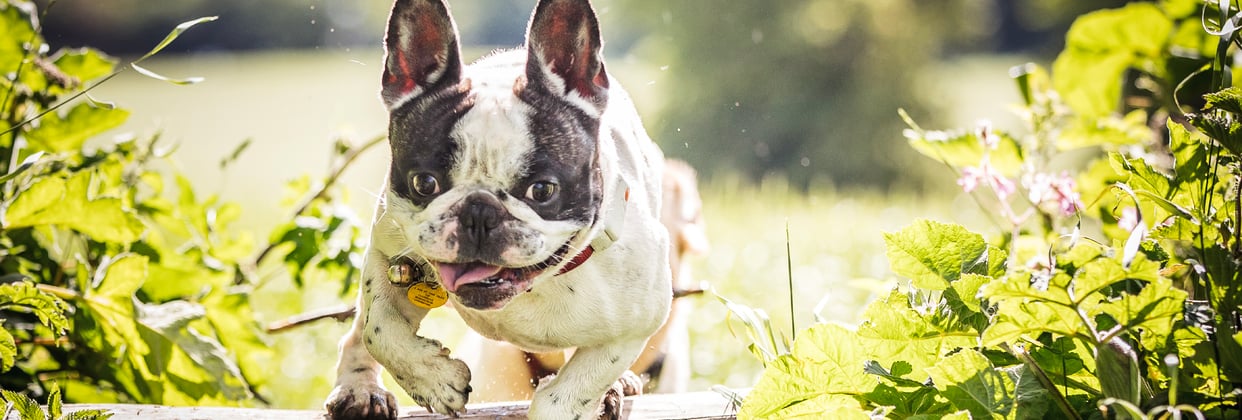

Behaviour
Living with a French Bulldog is a continuous joy, but there are a few quirks to be mindful of. For instance, Frenchies often snore due to their brachycephalic structure.
They can also be a bit stubborn at times. Persistence, patience, and gentle training methods will go a long way.
Do French Bulldogs bark a lot?
French Bulldogs don’t typically bark as much as, say, a terrier, making them easier for neighbours to handle.
But, remember that every dog is unique. With proper guidance, you can shape a well-rounded companion who’s a delight both inside and outside the home.
Training a French Bulldog.
Are French Bulldogs Smart?
Yes. They’re bright little dogs who love your attention. Because of that ‘attached-to-their-owners’ nature, many Frenchies are eager to please.
Still, there’s a dash of Bulldog stubbornness to be aware of.
Commands such as sit, stay, and come should be introduced with positive reinforcement. Lavish them with praise, small treats, or quick play sessions as a reward.
Training is often simpler if begun in puppyhood, but like all dogs, adult Frenchies can learn new tricks so just be consistent.
If you sense frustration creeping in, switch tactics. Brachycephalic breeds can also overheat quickly, so keep training sessions short and avoid working outdoors in midday heat.
House training
Compared to some other small dogs, French Bulldogs can be slightly slow to master bladder control.
They have a limited capacity, especially when they’re young. Tips to help? Keep to a strict schedule, praise them heavily when they go outside, and don’t punish accidents.
If you prefer a puppy pad, place it in the same spot each time, reinforcing the idea that there’s only one approved “indoor” potty location.
Patience is key, and positivity is everything. If you’re stuck, speak to a vet or a dog trainer for personalised suggestions.
You can also read our advice on puppy toilet training for extra guidance on setting routines.

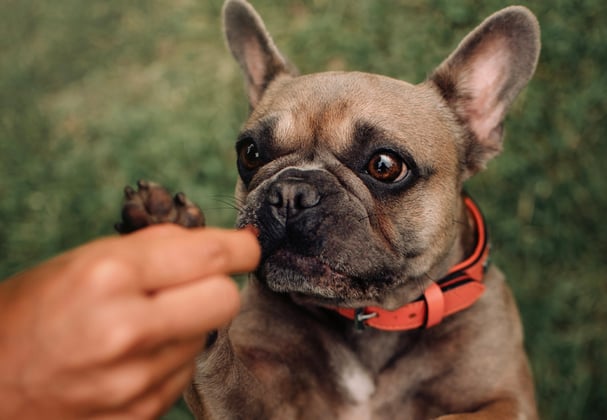
Socialising with larger dogs
In many cases, French Bulldogs can play well with bigger canines, especially if they’re introduced gradually in calm surroundings.
They aren’t known to be shy or timid, but they might show some protective instincts. If you notice any tension, step in gently before conflict escalates.
The more positive interactions your Frenchie has with other dogs from puppyhood onward, the more confident they’ll be.
Shedding and grooming.
Short coat, easy grooming
The French Bulldog’s coat is short, making them relatively low-maintenance. Still, it’s important to know that skin fold dermatitis can be a concern in the wrinkles around their face and tail area.
Clean those folds regularly with a gentle cloth or vet-approved wipe to remove moisture, debris, or bacteria. Doing so helps ward off infections and keeps your Frenchie comfortable.
A quick brushing session once or twice a week ensures that dead hairs are removed. During seasonal shedding, you might need to brush them more frequently.
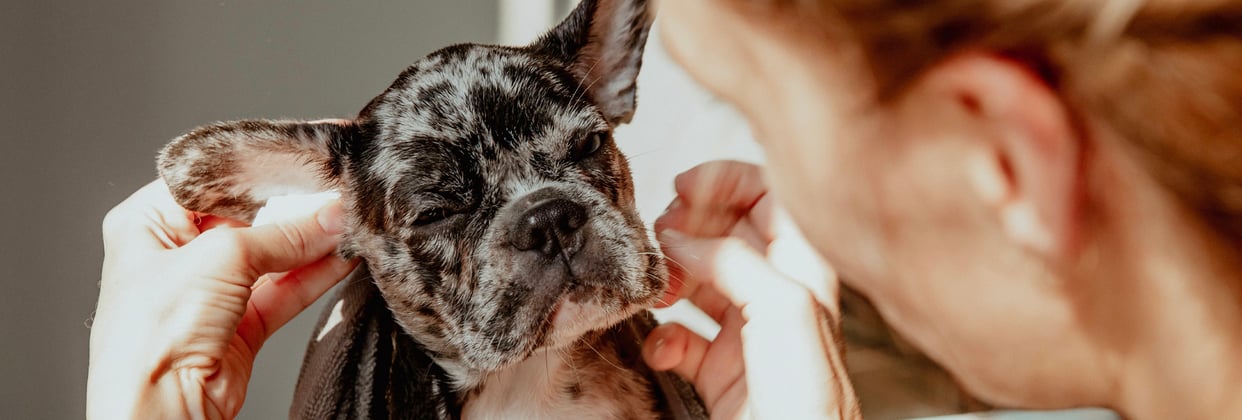

Nail care and ear cleaning
Because Frenchies have those iconic bat ear shapes, dust or wax can build up inside. Check their ears weekly and use a veterinarian-approved cleaner if necessary.
Likewise, keep nails trimmed. Overgrown nails can affect gait and cause discomfort over time. Gentle and consistent maintenance helps your dog remain happy and active.
Exercise and mental stimulation.
Don’t overdo it
French Bulldogs, being brachycephalic like Pugs, have shortened airways. While a certain level of daily exercise is crucial to keep them fit and healthy, brachycephalic obstructive airway syndrome means they may not tolerate long or intense workouts, especially in warm weather.
A 15-30 minute daily walk at a relaxed pace is often sufficient.
Heatstroke is a real threat to brachycephalic pups. On hot days, limit outdoor excursions, make sure there’s shade, and bring along plenty of fresh water.
If they start panting excessively or struggling to breathe, head home and cool them down.


Mind games
It’s not just about physical exertion, Frenchies need mental challenges. Puzzle toys, treat-dispensing gadgets, or learning a new trick helps stave off boredom.
You could even hide small bits of kibble around the living room and let them “hunt.” This is an excellent way to satisfy natural curiosity while encouraging them to move.
If you ever wonder why mental stimulation is so essential, check out our piece on how to make your dog happy. We chat about creative ways to keep different breeds engaged and thriving.
Feeding and nutrition.
How much should a French Bulldog eat?
It varies depending on their weight, age, and activity level. On average, French Bulldogs typically consume about 1 to 1.5 cups of high-quality dog food per day (split into two meals).
Always choose food that aligns with their life stage whether puppy, adult, or senior.
Because Frenchies can be prone to weight gain, avoid overfeeding or overdoing the treats.
Obesity exacerbates breathing and joint issues, so a leaner Frenchie is a healthier Frenchie.
Common health issues in French Bulldogs.
French Bulldogs are prone to several health issues due to their unique anatomy and genetics.
Below is a summary of common health concerns and their associated treatment costs:
Note: Costs are approximate and can vary based on location and specific veterinary practices.
Dental concerns
With that short jaw, teeth can be crowded, leading to plaque build-up and gum disease. Regular tooth brushing or dental sticks make a big difference.
If you need pointers, our pet dental care resource can help you navigate brushing frequency and product recommendations.


Higher risk of developing other issues
As a purebred line, Frenchies can face a few genetic predispositions. Ear infections, spinal malformations, or certain neurological disorders are not unheard of.
That doesn’t mean your Frenchie will definitely face these problems, only that it’s important to know about them.
Spotting signs early and forging a close relationship with your vet can be a literal lifesaver.
Pet insurance for French Bulldogs.
Owning a French Bulldog can be unbelievably rewarding, yet their predisposition to certain health issues (especially those involving the respiratory system) makes robust dog insurance a wise choice.
Surgeries or long-term treatments for brachycephalic obstructive airway syndrome can be costly.
Insurance might also help with things like ongoing medication, allergy treatments, or advanced diagnostics.
At Waggel, we’re all about ensuring you have the right coverage for your pup. If you’re specifically seeking insurance to help with breed-related concerns, we have plans that consider health and temperament nuances.
Our coverage includes:
Lifetime coverage for chronic conditions
24/7 online vet triage through Joii
Behaviour and nutrition consultations
We know that each Frenchie is unique, but comprehensive insurance ensures you never have to compromise on medical care.
If you’d like to explore your options, why not get a free quote? We’d love to chat about how to keep your dog protected and comfortable throughout every stage of their life.
If you’re wondering whether your Frenchie might need extra coverage, our general breakdown of the ins and outs of pet insurance can help you make an informed decision.
It covers everything from typical policy terms to what’s commonly excluded.

